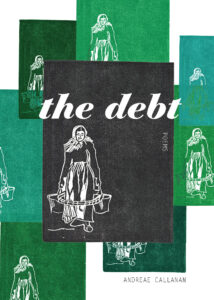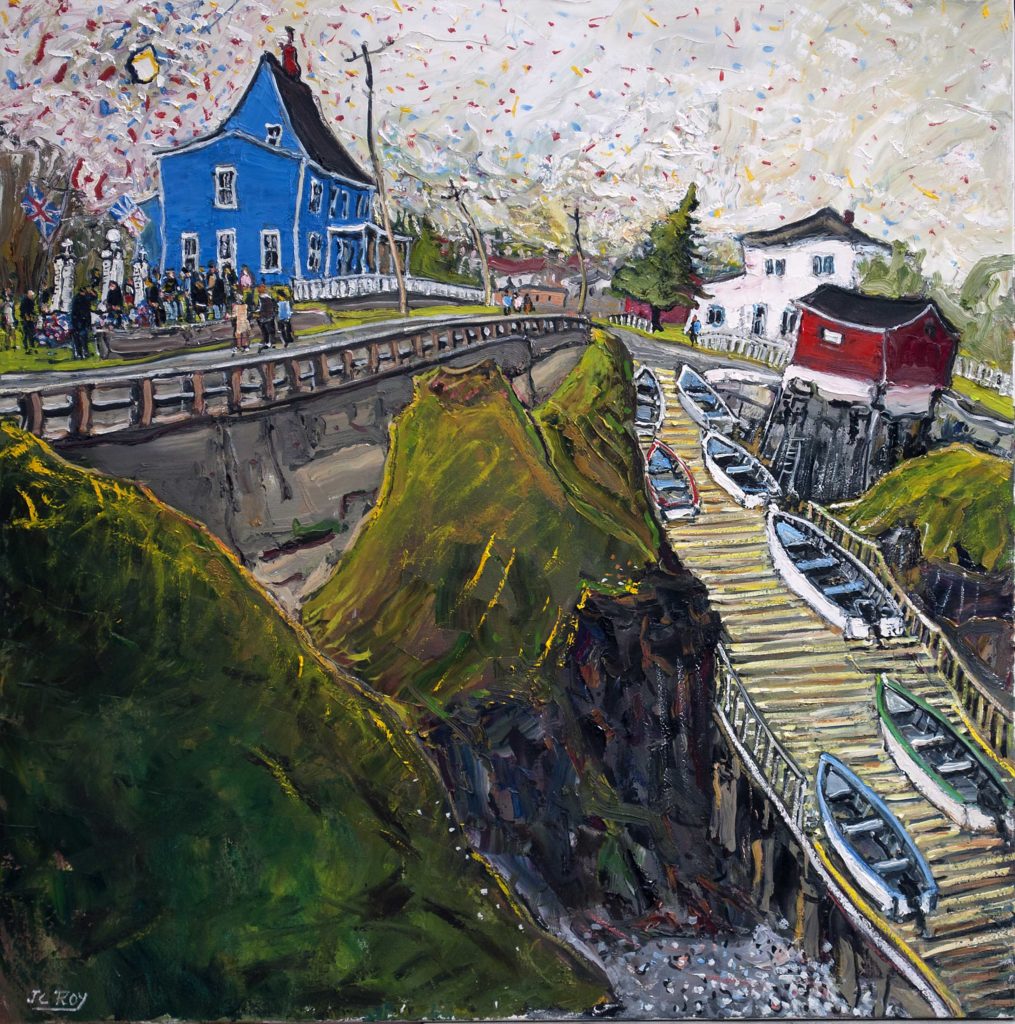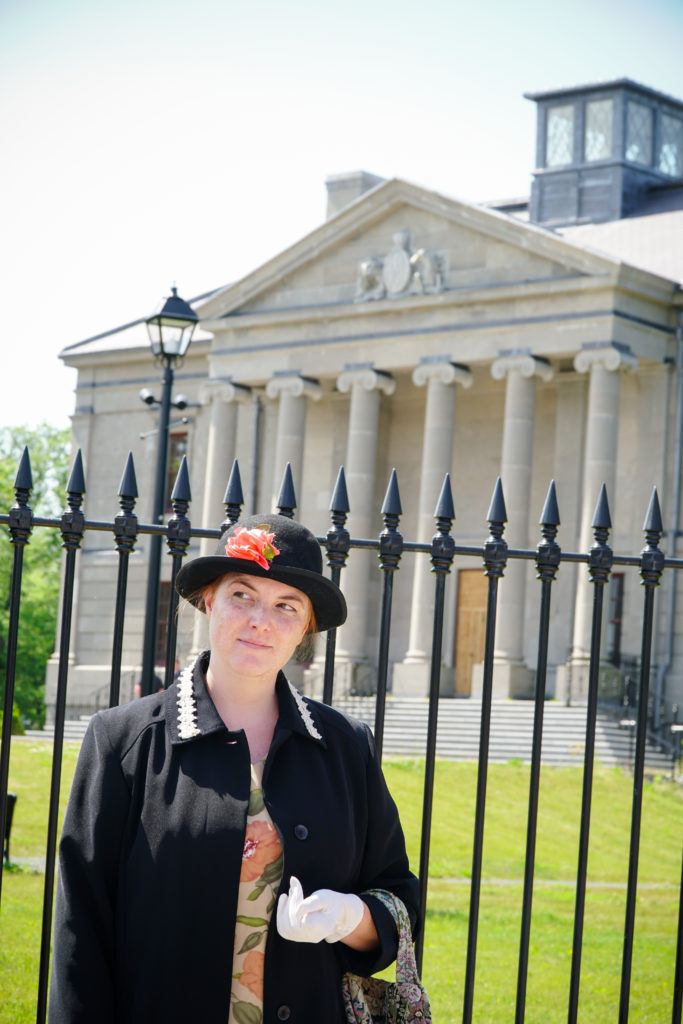Andreae Callanan: a memory for sensory detail
June 2021
Can you tell us a little about yourself?
I grew up on the east side of downtown St John’s, and now I’m raising my family on the west side of downtown St John’s, so that’s either a triumph or a tragedy, depending on where one’s townie loyalties lie. My husband Mark (Callanan, poet) and I live with our four kids and one ornery cat in a pre-Great Fire house that keeps threatening to slide down the hill and into the harbour. I’m in the third year of my PhD program at Memorial, I’m a Vanier Canada and Pierre Elliott Trudeau Foundation scholar, and I teach creative writing in the English Department whenever the opportunity arises.
What artists, not necessarily writers, influence you?
About 20 years ago a professor of mine described my poetry as “Martha Stewart meets Edward Gorey,” which was weirdly apt. Mary Pratt is in there, of course. I love her work’s eerie, unsettling edge. I love her hyperreal domesticity, the religious illumination treatment she gives to secular household scenes. If I could do in verse what Pratt did with light, I’d die happy.
In terms of language, my greatest influence is probably Bob Dylan, which I feel a bit sheepish about because, really? Bob Dylan? But I find myself in awe of his structural prowess all the time, even when his lyrics don’t make a lick of sense.
You seem to derive inspiration from paying special attention to events or subjects others would overlook, or take for granted – mittens, for example. Have you always had this skill for observation, or is it something you actively practice?
Oh, that’s always been my mode, for better or worse. Two years ago, I was diagnosed with ADHD, and over the following year I learned that I’m autistic as well. One of the distinguishing features of autism is what’s called a “detail-oriented cognitive style,” which is exactly what it sounds like: autistic brains tend to perceive things as a collection of discrete parts rather than as a unified whole. This is why one of the classic screening questions for autism in children is whether, if handed a toy truck, the child will push it along the floor and make “vroom-vroom” noises or hold it up to their eye and watch the wheels spin. A non-autistic child will perceive the object as a representation of a familiar vehicle; an autistic child is just as likely to see it as some wheels and axles attached to a vaguely truck-shaped handle (which, if you ask me, is much more fun).
As for ADHD, that condition makes it difficult to filter out extraneous details from important ones in any given situation. This is great for writing poetry, because those details that might otherwise be deemed extraneous are what make a poem come alive. It’s less useful for, say, driving a car, because I can’t always tell an interesting detail (a bird flying up into somebody’s eaves) from a crucial one (an intersection). My brain prioritizes every bit of sensory input pretty much equally, so it’s safer for everyone if I just write poems and travel by foot.
Your poems have a sense of place, from the Christmas market at Brussels to a waiting room outside an ICU. I’m presuming you don’t sit down in the middle of a hospital ward and start writing – do you keep a notebook or journal that you refer back to?
I’m not much of a notebook-keeper, no. I have a great memory for sensory detail and impressions, and I’ll often just retain all these little fragments, then put them together later to conjure a specific place. I don’t have much of an imagination for narrative or for world-building, but I’m good at describing things I’ve seen or heard.
It takes me a while to process information, and I take a lot of walks to reflect on things that have happened and to figure out how I feel about them. That’s when these sensory fragments come to the surface, and they usually come in a fairly metrical fashion, because, well, I’m walking, and the words can’t help but fall in step. Meter is a powerful mnemonic; once my thoughts have arranged themselves into a metrical pattern, I can carry them home in my head and get them onto paper, and then the poem usually grows from there.
You’ve written an accessible and sumptuous cooking column (for The Scope, right?), and there several poems in The Debt are about food. With four children cooking must be a constant activity. Do you enjoy it?
I do, but cooking has changed a lot for me since then. When The Scope started I was a single parent of one preschooler; now, that preschooler about to head off to university, I have three more kids, and I have a spouse I can rely on to share cooking duties. My eldest has always been an adventurous eater, while my younger kids are much more selective. There were a few years where all we could get anyone to eat were store-brand chicken nuggets and buttered noodles. We’re not out of the buttered noodle phase yet, if I’m honest, and we may never be. I can’t say I’ve enjoyed that.
Still, I’m happiest in the kitchen. I’ve always found the rhythms and structures of cooking, and of baking especially, deeply soothing. I was just reading the introductory essay of Nigella Lawson’s new book, Cook, Eat, Repeat, and Lawson refers to day-to-day cooking as “a balm for the buzzing brain.” (Lawson’s another name for my list of greatest influences – she’s an outstanding essayist.) Often, when I’m trying to puzzle through an intellectual problem, I’ll bake something that matches the problem in terms of complexity. Food shows up in my poetry, and poetry shows up in my food; I realized a few years ago that the structure of a Petrarchan sonnet perfectly mirrors the ratios I use when I’m making jam.

I really like the look of the book. Did you select the cover image (Diana Daly’s Water Carrier 1)?
Thank you! Diana and I are old friends, and it meant a lot to me to have her be a part of the book. Most people probably associate her name with the performing arts, but she’s been making wonderful linocut prints for a while now; she studied under Lyne Bastien back in 2014, when she was living in Puvurnituq, Nunavik, and she’s on the board of directors St Michael’s Printshop. She’s a true multi-disciplinarian. A Renaissance woman!
I knew I wanted an image of a woman carrying pails of water – it was my editor, Luke Hathaway, who picked that image out from the collection as a perfect emblem for the book, and he was totally right. I wanted something graphic and stylized, with a sense of movement, and I knew Diana would knock it out of the park. She made the piece especially for the book. There’s a companion piece, as well, that didn’t make it onto the cover but that’s just as wonderful.
And what’s a book you’re reading and/or a film or TV show you’re watching now?
I’ve just started Stephen Kuusisto’s Eavesdropping: A Memoir of Blindness and Listening, which is gorgeous so far. I’m picking my way through the essays in We’re On: A June Jordan Reader; Jordan was an extraordinary thinker and I’m just getting to know her work now. And there’s the aforementioned Nigella Lawson, of course. TV-wise I’m watching the new season of Ms Fisher’s Modern Murder Mysteries, which is an absolute romp.
Andreae Callanan’s The Debt is available from Biblioasis ($19.95)



